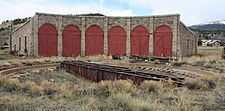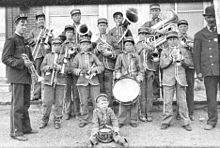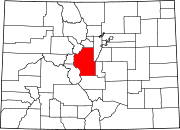Como, Colorado
This article needs additional citations for verification. (February 2011) |
Como, Colorado | |
|---|---|
 Como Roundhouse is the only narrow-gauge roundhouse still standing in Colorado. Until 1937, it handled repairs on the railroads. In 1938, the remaining tracks were removed. | |
| Country | |
| State | |
| County | Park County[1] |
| Elevation | 9,813 ft (2,991 m) |
| Time zone | UTC-7 (MST) |
| • Summer (DST) | UTC-6 (MDT) |
| ZIP Code[2] | 80432 |



Como is an unincorporated community in Park County in the Rocky Mountains of central Colorado, United States. According to the 2010 census, the population is 439.[3]
History
It is believed the town was named by miners from Como, Italy, who worked the coal fields of the area. In 1879, the town became the location of a depot of the Denver, South Park and Pacific Railroad, which was extended over Kenosha Pass to reach the silver mining areas during the Colorado Silver Boom. Later, the town served as a division point for trains going northward over Boreas Pass and southward toward Garos and over Trout Creek Pass at the western end of South Park. The town has many historic weathered structures, including the roundhouse, hotel, and depot and has the air of a ghost town that is still nevertheless populated, by twenty people. It has a small commercial district consisting of a post office, gallery, hotel. The depot has been renovated with plans to make it an area tourist attraction.
With a population in the 1910 census of 475, 36 more than in 2010, Como was then the largest community in Park County. There were eighty-three children of school age that year. The former Como High School had begun in an abandoned Presbyterian Church, which was moved to another site. The school closed in either 1940 or 1941, by which time railroad service to Como had already ended some three years earlier. The remaining pupils were bused to Fairplay. The old Como High School building was left intact and used for the storage of decades of school records and memorabilia, items which were rediscovered in the 1990s. The former school, with a well-preserved classroom, is open to the public only once annually, on Boreas Pass Railroad Day, but students may visit on field trips. The school provides a glimpse into yesteryear.[4]
Geography
Como is located at the northern end of South Park, Como is an historic railroad settlement. It sits approximately one-half mile (1 km) west of U.S. Route 285 and some nine miles (15 km) northeast of the county seat of Fairplay. Como is accessible by a paved County Road 33, which becomes gravel inside the town. Boreas Pass Road runs northwest over Boreas Pass to Breckenridge. The mountains northwest of Como form a dramatic background to the site of the town on the flank of Little Baldy Mountain.
Economy
The U.S. Post Office in Como (ZIP Code 80432) is located within Mountain Man Gallery, an art gallery which displays the work of mainly local artists.[5] Other businesses in the community are the Como Depot and Eating House, a bed and breakfast open seasonally,[6] and Experienced Goods Antique which sells miscellaneous matters, including books.[7] There is also a summer camp/retreat center in Como called Camp Como.
Notable people
On May 13, 2011, Marshal Adolph E. Cook of Como was inducted into the National Law Enforcement Memorial in Washington, D.C. Earlier in 1999, he was inducted into the Colorado Law Enforcement Memorial. He is the only law enforcement officer from Park County to qualify for in his case posthumous honors. Cook was shot to death in 1894 when he came to a Como residence to break up a loud party. Two women at the party, including Anna Blythe Speas, were charged with accessory to murder but acquitted. Speas' tragic life story is told in the book Historic Tales from Park County: Parked in the Past by the journalist Laura King Van Dusen, who writes for the newspaper The Flume in Fairplay.[8]
See also
- Denver-Aurora Metropolitan Statistical Area
- Denver-Aurora-Boulder Combined Statistical Area
- Front Range Urban Corridor
- List of cities and towns in Colorado
References
- ^ a b "US Board on Geographic Names". United States Geological Survey. 2007-10-25. Retrieved 2008-01-31.
- ^ "ZIP Code Lookup" (JavaScript/HTML). United States Postal Service. December 22, 2006. Retrieved December 22, 2006.
- ^ "2010 Census Population for ZIP Code 80432". zip-coedes.com. Retrieved February 4, 2014.
- ^ Laura King Van Dusen, "Como High School: An Unplanned Time Capsule of Earlier Days, Artifacts Uncovered from Como's Heyday," Historic Tales from Park County: Parked in the Past (Charleston, South Carolina: The History Press, 2013), ISBN 978-1-62619-161-7, pp. 163-169.
- ^ "Mountain Man Gallery and Custom Framing". mountainmangallery.com. Retrieved February 4, 2014.
- ^ "Como Depopt (Colorado Hotel)". comodepot.com. Retrieved February 4, 2014.
- ^ "Experienced Goods Antique". squareup.com. Retrieved February 4, 2014.
- ^ Laura King Van Dusen, "The Short, Tragic Life of Anna Blythe Speas: Belle of Boulder, Suspected Criminal in Como, Dead in Denver at Twenty-eight", Historic Tales from Park County: Parked in the Past, pp. 113-125.

